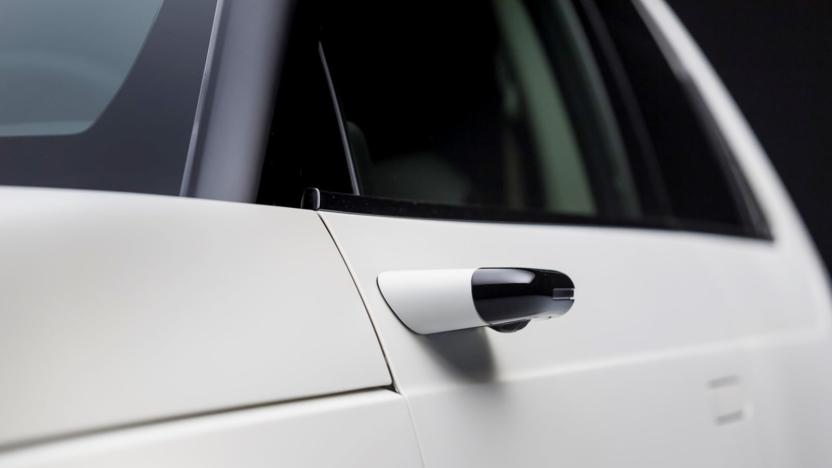aerodynamic
Latest

Honda's compact EV swaps mirrors for side cameras
Not only will Honda's cool little electric vehicle, the Honda E, come with cameras instead of side mirrors, they'll be offered as a standard feature. The compact cameras will sit where their mirror predecessors did, and inside, drivers will find a six-inch screen at each end of the dashboard. Honda says they'll reduce drag, boost efficiency and offer a better perspective.

Volkswagen's XL1 concept plug-in diesel hybrid has 260MPG fuel efficiency, questionable aesthetics
Steaming down the autobahn could be about to get a whole lot more efficient. Volkswagen has carted out its newly updated Super Efficient Vehicle concept, now dubbed the XL1, which -- after a great deal of fuzzy math, we're sure -- is rated at a 313MPG fuel efficiency and produces only 24g of CO2 per kilometer traveled. There's an electric motor and a TDI diesel engine making all the buzzing and roaring noises inside, while the overall body design is focused on making the car as light and as aerodynamic as possible. Volkswagen has achieved a 795kg curb weight by using carbon fiber, magnesium, ceramics, and aluminum to shave down any excess portliness from the XL1, while wind-tunnel testing and optimizations have resulted in a rather exemplary 0.186 drag coefficient. It's rare to see such attributes on anything outside the supercar realm, but then there's a reason why this PHEV is still only a concept. FOF. Update: Oh bother. Turns out Volkswagen's mileage claim is based on Imperial gallons, which are 1.2 times the size of the American stuff, meaning that the XL1 actually measures in at 260MPG when viewed through US glasses. Now do you see why the rest of the world has gone metric?

Inhabitat's Week in Green: surfing renewable energy, hexagonal LEDs, and ultra-efficient aerodynamics
The Week in Green is a new item from our friends at Inhabitat, recapping the week's most interesting green developments and clean tech news for us. This week Inhabitat reported live from the scene of New York Design Week, where we sifted through thousands of new home furnishings and interiors products to bring you the state-of-the-art in green design. Fresh from the floor of the International Contemporary Furniture Fair is this stunning hexagonal crystal LED light, which is composed of glowing geometric blocks that snap together to form a myriad of shapes. We were also impressed by this beautifully finished wood calculator that multiplies its green factor with sustainably-sourced materials. The past week was also surging with developments from the field of renewable energy - first we were excited to see the unveiling of the Oyster 2, an offshore wave-harvesting energy plant that improves upon its predecessor with a simpler design, fewer moving parts, and a 250% increase in energy generation. Google, HP, and Microsoft are also getting into the green energy game with plans to tap an unexpected energy source to run their data centers - cow dung! Google also led the charge towards cleaner energy this week by funding a new type of jet engine-inspired geothermal drill that uses superheated streams of water to bore through previously impenetrable surfaces. Speaking of jets, MIT has just unveiled several ultra-efficient airplane designs that are capable of cutting fuel use by a whopping 70%. The auto industry also received a jolt of energy as Toyota announced a partnership with Tesla that will boost California's flagging economy and likely lead to more affordable iconic electric vehicles. The field of wearable technology saw several innovative advancements this week as well - safe cyclists rejoice, because a group of Indian students have designed a $22 Solar and Wind Powered Bike Helmet. Meanwhile, a group of Colorado State University seniors have designed a medical incubator backpack unit that they believe can reduce baby deaths in medical emergencies. Finally, we shined light on several brilliant advancements from the field of solar technology, starting with China's plans to build the "biggest solar energy production base" in the world. We also looked at the HYDRA, a solar-powered hydrogen fuel cell system that can reportedly generate 20,000 gallons of pure water a day, and green energy got literal with the unveiling of the first leaf-shaped crystalline silicon solar panels.

Memorex's M-Flyer Pilot USB drive gets its wings
Granted, we're not exactly grasping the full connection between aircrafts and Memorex's TravelDrive M-Flyer Pilot, but the sleek, "aerodynamic" design and cutesy wing logo probably make this the USB flash drive of choice for the average commercial pilot. Regardless, this minuscule device touts a retractable, capless design, ReadyBoost compatibility, and comes with Portable Vault USB security software from Migo Software. Available in 2GB and 4GB sizes, the latest M-Flyer should be available in the US and Canada next month for $49.99 and $79.99, respectively.

